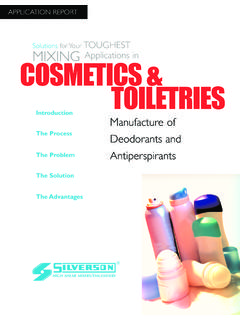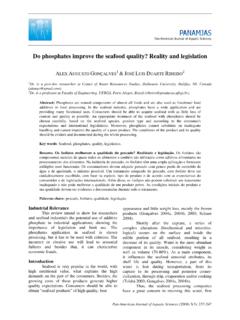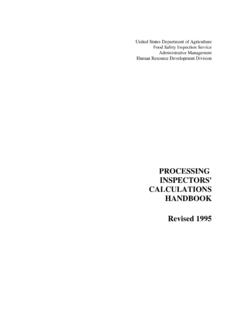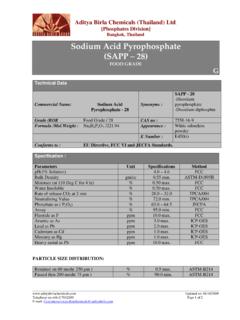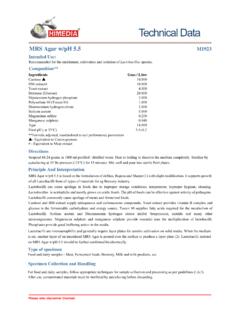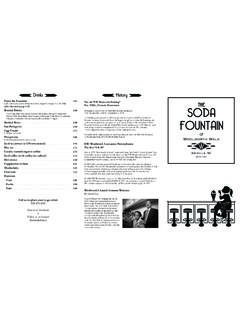Transcription of Solutions or Yf our TOUGHEST MIXING Applications …
1 APPLICATION REPORT. Solutions for Your TOUGHEST . MIXING Applications in FOOD. Introduction Preparation of Brines The Process for the Meat Industry The Problem The Solution The Advantages HIGH SHEAR MIXERS/EMULSIFIERS. FOOD. Preparation of Brines for the Meat Industry A number of functional ingredients are added to meat to act as preservatives, flavoring, coloring etc. These are generally dissolved into water to form a brine which is then injected into the meat. Another purpose of the brine is to increase the volume and weight (or yield) of the increase in yield varies widely according to type, price and quality of the finished product, typically from below 15 to more than 50%. Traditional brines consist of just water, salt, and sugar; most formulations are more complex; many different ingredients are used (subject to legislation) for a number of functions as illustrated in the following table: % in Ingredient Typical % finished Function in solution product up to Salt (NaCl) 2% Flavoring and preservative.
2 12%. Sucrose/saccharose. Flavoring, also contributes to preservative Sugar up to 6% 1-2% effect. Other sugars dextrose, maltodextrins etc. are used to increase solids content where a high yield is desired Nitrites and < Sodium nitrite/sodium nitrate. Preservative which forms the stable nitrates pink color of processed meats. Used where a higher yield is required, polyphosphates increase the Phosphates up to 4% water binding properties of the product, allowing an increase of up to 50% and more. varies For increased water binding for yields of up to 40-50%. Stabilizers widely also improve texture ( mouthfeel ). They are widely used in low- Proteins and from fat processed meat products. hydrocolloids (gums) to Animal proteins include whey proteins, caseinates, blood proteins, 8% collagen, gelatine (starches) Vegetable products include soy proteins, starches, carrageenan, locust bean gum, guar gum, xanthan gum Antioxidants Sodium ascorbate, sodium erythorbate Flavor Monosodium glutamate, sodium guanylate, hydrolysed Enhancers meat/vegetable proteins The Process Brine Solutions are normally prepared on demand.
3 Small trolley-mounted vessels are commonly used, although larger batches are produced in bulk manufacture. Additional process requirements include: The mixer must be capable of completely dissolving solids such as sugar and salt to ensure they do not block the injection system, and to attain their functionality. Similarly, stabilizers must be properly dispersed and completely hydrated to produce an agglomerate-free solution. The brine must be stable to prevent separation or sedimentation. Rectangular vessels ( tote bins) are often used. Maintaining vigorous in-tank movement is essential to ensure solids do not remain undissolved or precipitate in these less than ideal MIXING vessels. Temperatures must be kept low throughout the process.
4 In some cases ice is added to the solution to maintain the required temperature. The MIXING equipment must be resistant to abrasion/corrosion. The Problem Dissolving the salt and sugar at these relatively low concentrations is a fairly simple task which can be adequately carried out using a conventional agitator. However, several problems can be encountered: Formulations with higher concentrations of salt have a high This requires the input of considerable energy to fully solubilize the salt, particularly at ambient or reduced temperatures. Phosphates are very difficult to dissolve. Incomplete solubilization can cause water to separate from the meat after processing. Stabilizers tend to form agglomerates which cannot be broken down by agitation.
5 Long MIXING times are required to fully hydrate and dissolve the solids. This can cause an undesired temperature rise. When ice is added to cool the product, it can take a long time to liquefy under agitation, reducing its cooling effect. FOOD. The Solution A Silverson High Shear mixer can dramatically reduce processing times, and improve product quality and stability. Due to the small volumes involved, a Batch mixer is most suitable, (although In-Line machines are sometimes used for large volumes). A typical MIXING process would be as follows: 1. The mixer is positioned so as to create a vortex and the powder is added straight into it. 4. When all the light powders Phosphates should be added have been incorporated, the first as other ingredients ( mixer is repositioned to reduce salt) can react with the the vortex.
6 Phosphates making dissolving more difficult. 5. The salt and sugar are added and, being denser than the other 2. The high speed rotation of ingredients they sink to the the mixer's rotor blades creates bottom of the vessel. The a powerful suction which draws particles are drawn upwards the water and solids into the into the workhead and workhead. subjected to intense high shear as before. Particle size is progressively reduced with each 3. The materials are subjected pass through the workhead. to intense shear in the confined Solubilization is completed in a area of the workhead before short space of time. being forced out through the stator. Once the phosphates have been dispersed, other hydrocolloids can be added.
7 The Advantages An agglomerate-free mix can be produced in a fraction of the time taken by conventional mixers Rapid MIXING time minimizes temperature rise Rapid powder absorption rate minimizes operator error Yield of stabilizers is maximized, reducing costs Stable brine solution will not separate out from the finished product after injection Consistent product quality and repeatability Batch mixers can be used on mobile floor stands allowing them to be moved from vessel to vessel Vigorous in-tank movement overcomes the difficulties associated with rectangular vessels All the mixer's product contact parts are in 316 stainless steel; cast iron or stainless steel motors should be specified Silverson Machines,Inc.
8 355 Chestnut Street, East Longmeadow, MA 01028. Ph: (413) 525-4825 Fax:(413) 525-5804 Issue No. 48FA2. Information contained in this report is believed to be correct and is included as a guide only. No warranty is expressed or implied as to fitness for use or freedom from patents. Silverson Machines reserve the right to change product specification without notice.





